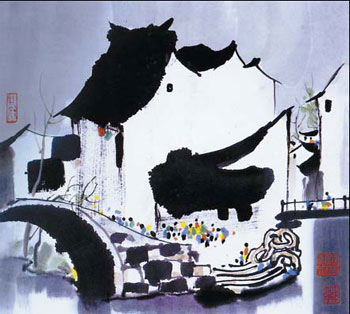"It's like climbing a mountain from different sides. Landscapes on the two sides may look different at the foot of the mountain, just like the scenes on the Nepalese and Chinese sides at the foot of Mount Qomolangma," he says.
"But the higher the mountaineers go up, the more similar the scenery becomes. The mountain-scape becomes exactly the same when the two climbers finally get to the top."
In fact, Wu argues that Chinese and Western arts communicate with each other. What make them feel different are the superficial mediums such as ink, rice paper, oil paint and canvas.

Glamour, ink-and-color, 2007.
However, Wu's approach of "capturing the beauty from the outset", his advocacy of formal beauty and his remark - "brush and ink equal zero" - ignited a fierce debate among Chinese ink painting circles in the 1990s.
Some critics even called Wu a traitor of Chinese painting traditions, while others said that Wu did not really grasp the gist of Chinese ink art.
"What I have been doing is digging up the essence of beauty in Chinese painting, which is hidden from most Westerners by Chinese brush strokes and the Chinese way of coloring, and I have tried to present it to people other than Chinese or Asians in a way that they understand," Wu says.
In Wu's view, anatomical analysis, perspective and three-dimensional expression in paintings constitute the very basis of Western art, allowing it to depict faithfully the texture, size, color, and shape.
Modern Western art, however, discards unnecessary details and concentrates on capturing the underlying beauty, mood and emotions.
In contrast, traditional Chinese painting has not gone through the baptism of systematic techniques and formal expression, Wu says.
So, its forms of expression are rather limited.
"I wanted to use the Western artistic scalpel and microscope to sum up, enrich and push forward Chinese painting traditions. Of course, I also wanted useful elements in Chinese art to remain instrumental in my painting," Wu says.
In 2007, Wu again sparked a public debate when he openly criticized the rigidity and bureaucracy of the official Chinese Artists Association and the Chinese Ink Painting Academy system.
"We all know that poets do not trade their poems for money; like poets, artists should support themselves, instead of relying on salaries from the government," Wu says, suggesting that the official institutes for Chinese art should be disbanded and all the artists should find their place in the art market.
However, when asked whether he cares about the astronomical prices that his paintings fetch at auctions, Wu replies with a smile: "No. I understand there are speculations in the art market; I am not sure whether the auction prices indicate the real value of paintings. But one thing is for sure: I believe paintings that can withstand the test of time are real masterpieces."
At 89, Wu still paints almost every day, while the rest of life is relatively simple.
"I do not raise a cat, dog or plant flowers. Nor do I indulge in music. Painting is my lifetime hobby and the pillar of my soul," Wu says.
(China Daily March 11, 2008)